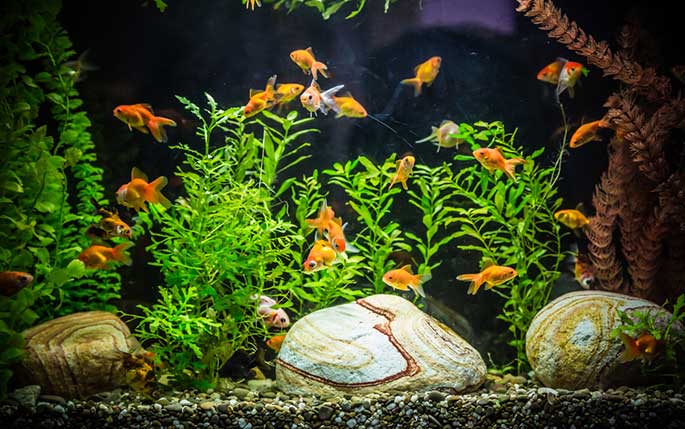
Tropical fish care guides are quite rare and niche, yet sought after by many beginners to make aquarium care easier for them. It is a great hobby that sets the mood for the home, that can be extremely beautiful and relaxing. But maintaining that fresh and aquatic life can be difficult for new fish hobbyists.
Tropical fishes have certain needs and need to be taken care of accordingly if you want a healthy fish that survives for long.
Many questions can pop up in your mind.
Like, what is the easiest tropical fish to take care of? Or how do you set up a tropical fish tank for the first time?
And one of the most important questions is: are tropical fishes hard to keep?
Worry not, all of these questions will be discussed in this article in one form or another
Read More:
- 8 Accessories Every Aquarium Needs
- A Beginners Guide to Setting up a Home Aquarium
- Can A Dog And A Fish Tank Co-Exist?
- Ways to Keep a Dog And a Fish Tank at the Same Time
- 5 Top Tips for How to Take Care of a Fish for Complete Beginners
- Aquarium Care For Beginners Made Easy
The Main Factors In Caring For A Tropical Fish
There are a few things that you always need to look out for when having a tropical fish aquarium.
- Filtration
- Air pumps
- Temperature control
- Feeding the fish
- The dissolved chemical content of the water
- Lighting
- Changing the water of the tank and cleaning the tank
Assuming you have taken one of the easiest tropical fish to care for at the start like Guppy, Molly, catfish, etc. These tips will be of major help for you if it is your first time setting up an aquarium. Feel free to read this tropical fish care guide.
1. Filtration And Aquarium Cover
Filters in a fish tank play a major role in keeping your tropical fish alive and healthy. The filter provides airflow and oxygen is dissolved by the movement of the water that it’s surrounded by. Filters also increase the much-needed water flow in the tank.
Filters clean off the waste created by the fish and the excess debris from the tank, to keep the surrounding water clean and non-poisonous.
Filters have an extra less known ability to promote the growth of beneficial bacteria that help the fish in the tank in many ways.
Covering the top of the aquarium can also keep any unwanted dust or contamination from getting into the fish’s environment. Avoid putting too many fishes at the same time in an aquarium
2. Air Pumps
To get the main misconception out of the way, air pumps are not needed to provide oxygen for the fish in most cases and are only used for decorations with added benefits for the fish.
Air pumps blow bubbles that create beautiful scenery inside the tank with the addition of air stones.
They have some lesser-known benefits, being needed in sponge filters to provide oxygen under the stones and dirt of the tank as well as make sure the bacteria in the tank can have enough oxygen.
They are also amazing for when you go out for long periods, by keeping the water oxygenated if you have a battery-powered pump. And air pumps can get very handy for a sick fish that needs higher temperature water. Because oxygen is in smaller quantities in high-temperature water the air filters often become insufficient to give enough oxygen and air pumps come into play.
3. Temperature Control with Heaters
Temperature is one of the main factors in tropical fish survival. They can’t be in too cold or hot weather. Heaters are needed for that, they keep the temperature regulated and stop the fish’s metabolism from slowing down or overheating in different climates.
Optimal temperatures for tropical fishes are 70 to 80 degrees Fahrenheit.
There is a need for caution when handling heaters to stop any abrupt temperature change and often heater’s thermometers will alarm you to any rise and fall in temperatures when necessary.
4. Feeding the Fish
A normal tropical fish needs food only once every two days. And in certain quantities depending on the species. Any overfeeding will leave scraps of fish food on the water that often become poisonous over time.
Normal dry fish food is often kept in dry, moisture fewer containers away from direct sunlight.
Frozen and live food needs to be stored accordingly, frozen food like a worm and other fish food can only be stored for three months at most before becoming harmful for the fish.
5. The Dissolved Chemical Content of the Water
Every fish needs certain chemical composition in the water to survive. And everything needs to be kept at constant levels.
PH needs to be measured with litmus or PH measuring devices or water quality testing kits. These kits often measure the content of nitrogen, oxygen, ammonia, and how saline the water is for the tropical fish.
Different species thrive in a certain proportion of chemicals in the water. And is very important to keep in mind if multiple species are in the same aquarium.
6. Lighting
Aquarium lighting is very important and different species of tropical fish live in different levels of luminosity zones in the water. This has to be precise and constant like the temperature, overly bright can blind some fishes and abrupt lighting can scare them.
Dimmer devices need to be installed with the lighting system or can come in a single package to slowly increase or decrease the lighting over time, simulating the day and night cycle.
Lighting is also very important as it disperses excess temperature and makes it harder for algae to thrive.
7. Changing the Water of the Tank and Cleaning the Tank
Tanks often need to have 20 percent of their water changed every two weeks or so, depending on what fish resides in it.
The aquarium and its decorations need to be cleaned including the gravel and uneaten food that the filter cannot cleanout. And this all has to be done by keeping the fish or fishes in another temporary tank for the time being till the cleaning is done.
To Conclude
Taking care of a tropical fish is not that hard. It needs patience and time. Which ultimately leads to a satisfying aquarium that is beautiful yet relaxing to observe.



